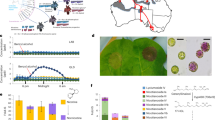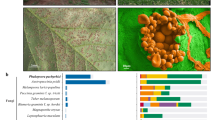Abstract
The publication of draft sequences for the two subspecies of Oryza sativa (rice), japonica (cv. Nipponbare) and indica (cv. 93-11)1,2, provides a unique opportunity to study the dynamics of transposable elements in this important crop plant. Here we report the use of these sequences in a computational approach to identify the first active DNA transposons from rice and the first active miniature inverted-repeat transposable element (MITE) from any organism. A sequence classified as a Tourist-like MITE of 430 base pairs, called miniature Ping (mPing), was present in about 70 copies in Nipponbare and in about 14 copies in 93-11. These mPing elements, which are all nearly identical, transpose actively in an indica cell-culture line. Database searches identified a family of related transposase-encoding elements (called Pong), which also transpose actively in the same cells. Virtually all new insertions of mPing and Pong elements were into low-copy regions of the rice genome. Since the domestication of rice mPing MITEs have been amplified preferentially in cultivars adapted to environmental extremes—a situation that is reminiscent of the genomic shock theory for transposon activation3.
This is a preview of subscription content, access via your institution
Access options
Subscribe to this journal
Receive 51 print issues and online access
$199.00 per year
only $3.90 per issue
Buy this article
- Purchase on Springer Link
- Instant access to full article PDF
Prices may be subject to local taxes which are calculated during checkout



Similar content being viewed by others
References
Goff, S. A. et al. A draft sequence of the rice genome (Oryza sativa L. ssp. japonica). Science 296, 92–100 (2002)
Yu, J. et al. A draft sequence of the rice genome (Oryza sativa L. ssp. indica). Science 296, 79–92 (2002)
McClintock, B. The significances of responses of the genome to challenge. Science 226, 792–801 (1984)
Arumuganathan, K. & Earle, E. D. Nuclear DNA content of some important plant species. Plant Mol. Biol. Rep. 9, 208–218 (1991)
Burr, B. Mapping and sequencing the rice genome. Plant Cell 14, 521–523 (2002)
Tarchini, R., Biddle, P., Wineland, R., Tingey, S. & Rafalski, A. The complete sequence of 340 kb of DNA around the rice Adh1–Adh2 region reveals interrupted colinearity with maize chromosome 4. Plant Cell 12, 381–391 (2000)
Jiang, N. & Wessler, S. R. Insertion preference of maize and rice miniature inverted repeat transposable elements as revealed by the analysis of nested elements. Plant Cell 13, 2553–2564 (2001)
Feschotte, C., Jiang, N. & Wessler, S. R. Plant transposable elements: where genetics meets genomics. Nature Rev. Genet. 3, 329–341 (2002)
Turcotte, K., Srinivasan, S. & Bureau, T. Survey of transposable elements from rice genomic sequences. Plant J. 25, 169–179 (2001)
Feschotte, C. & Wessler, S. R. Mariner-like transposases are widespread and diverse in flowering plants. Proc. Natl Acad. Sci. USA 99, 280–285 (2002)
Zhang, X. et al. P Instability Factor: an active maize transposon system associated with the amplification of Tourist-like MITEs and a new superfamily of transposases. Proc. Natl Acad. Sci. USA 98, 12572–12577 (2001)
Bao, Z. & Eddy, S. R. Automated de novo identification of repeat sequence families in sequenced genomes. Genome Res. 12, 1269–1276 (2002)
Hirochika, H., Sugimoto, K., Otsuki, Y. & Kanda, M. Retrotransposons of rice involved in mutations induced by tissue culture. Proc. Natl Acad. Sci. USA 93, 7783–7788 (1996)
Van den Broeck, D. et al. Transposon display identifies individual transposable elements in high copy number lines. Plant J. 13, 121–129 (1998)
Casa, A. M. et al. The MITE family heartbreaker (Hbr): molecular markers in maize. Proc. Natl Acad. Sci. USA 97, 10083–10089 (2000)
Bureau, T. E., Ronald, P. C. & Wessler, S. R. A computer-based systematic survey reveals the predominance of small inverted-repeat elements in wild-type rice genes. Proc. Natl Acad. Sci. USA 93, 8524–8529 (1996)
Zhang, Q., Arbuckle, J. & Wessler, S. R. Recent, extensive and preferential insertion of members of the miniature inverted-repeat transposable element family Heartbreaker (Hbr) into genic regions of maize. Proc. Natl Acad. Sci. USA 97, 1160–1165 (2000)
Mao, L. et al. Rice transposable elements: a survey of 73,000 sequence-tagged-connectors. Genome Res. 10, 982–990 (2000)
Rezsohazy, R., Hallet, B., Delcour, J. & Mahillon, J. The IS4 family of insertion sequences: evidence for a conserved transposase motif. Mol. Microbiol. 9, 1283–1295 (1993)
Ting, Y. The origin and evolution of cultivated rice in China. Acta Agron. Sinica 8, 243–260 (1957)
Glaszmann, J. C. Isozymes and classification of Asian rice varieties. Theor. Appl. Genet. 74, 21–30 (1987)
Wang, Z. Y., Second, G. & Tanksley, S. D. Polymorphism and phylogenetic relationships among species in the genus Oryza as determined by analysis of nuclear RFLPs. Theor. Appl. Genet. 83, 565–581 (1992)
Matsuo, T., Futsuhara, Y., Kikuchi, F. & Yamaguchi, H. Science of the Rice Plant (Ministry of Agriculture, Forestry and Fisheries, Tokyo, 1997)
Morishima, H. & Oka, H. I. Phylogenetic differentiation of cultivated rice. XXVII. Numerical evaluation of the indica–japonica differentiation. Jpn. J. Breed. 31, 402–413 (1981)
Kawakami, K., Shima, A. & Kawakami, N. Identification of a functional transposase of the tol2 element, an Ac-like element from the japanese medaka fish, and its transposition in the zebrafish germ lineage. Proc. Natl Acad. Sci. USA 97, 11403–11408 (2000)
Glaszmann, J. C. & Arraudeau, M. Rice plant type variation: ‘Japonica’–‘Javanica’ relationships. Rice Genet. Newslett. 3, 41–43 (1986)
Ueno, K. Differentiation of ecotypes in Oryza sativa L. 2. Characteristics of ecotypes: Japanese lowland and upland rice. Bull. Inst. Agri. Res. Tohoku Univ. 39, 43–49 (1988)
Yano, M. et al. Hd1, a major photoperiod sensitivity quantitative trait locus in rice, is closely related to the Arabidopsis flowering time gene CONSTANS. Plant Cell 12, 2473–2484 (2000)
McCouch, S. R. et al. Molecular mapping of rice chromosomes. Theor. Appl. Genet. 76, 815–829 (1988)
Baba, A., Hasezawa, S. & Syono, K. Cultivation of rice protoplasts and their transformation mediated by Agrobacterium Spheroplasts. Plant Cell Physiol. 27, 463–471 (1986)
Acknowledgements
We thank J. Edwards for help with database searches; C. Feschotte and E. Pritham for critically reading the manuscript; and D. Holligan and Y. Hu for technical assistance. This study was supported by a grant from National Science Foundation to S.R.E., S.R.M. and S.R.W.
Author information
Authors and Affiliations
Corresponding author
Ethics declarations
Competing interests
The authors declare that they have no competing financial interests.
Rights and permissions
About this article
Cite this article
Jiang, N., Bao, Z., Zhang, X. et al. An active DNA transposon family in rice. Nature 421, 163–167 (2003). https://doi.org/10.1038/nature01214
Received:
Accepted:
Issue Date:
DOI: https://doi.org/10.1038/nature01214
This article is cited by
-
Identification of transcriptionally active transposons in Barley
BMC Genomic Data (2023)
-
Mobility of mPing and its associated elements is regulated by both internal and terminal sequences
Mobile DNA (2023)
-
Molecular and biochemical characterization of rice developed through conventional integration of nDart1-0 transposon gene
Scientific Reports (2023)
-
Identification and characterization of transposable element AhMITE1 in the genomes of cultivated and two wild peanuts
BMC Genomics (2022)
-
Transposable element finder (TEF): finding active transposable elements from next generation sequencing data
BMC Bioinformatics (2022)
Comments
By submitting a comment you agree to abide by our Terms and Community Guidelines. If you find something abusive or that does not comply with our terms or guidelines please flag it as inappropriate.



